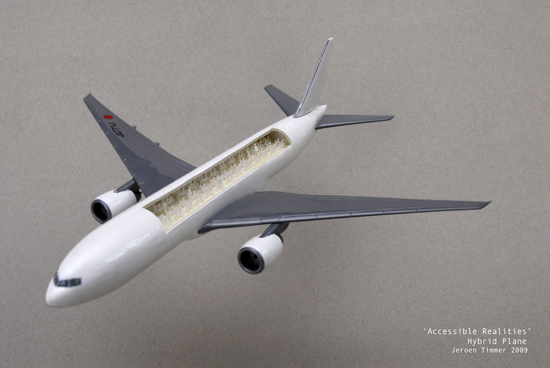
ACCESSIBLE REALITIES / AEROPLANES
Four visions on aircrafts. Each exploring a new way of airtravel and alternative power supplies. Balloon plane, Headwind plane, Mimic plane and Hybrid plane.
Air travel creates most pollution of all means of transport. A jumbo jet takes in 250.000 liters of jet fuel before taking off. The miracle of flying comes at a price. This solution was created in a time we still assumed resources could never be depleted. Now we know different and we should urgently research new ways to explore -and preserve- the planet.
Selected by Items Design Magazine for the End exam selection 2009.
Acknowledgements: Solkin Keizer (viewmaster illustrations), Mandenmakerij ‘De Mythe’ (willow model plane), Modelballonvaren (model hot air balloon), Mostafa Heravi (performance video registration), Amanda van Sloten (performance photo registration)
Year
2010Category
Experiment, Object
Balloon plane. 1:25 model – a huge hot air balloon combined with a woven willow plane. Silent way of transportation with the ability to get close to nature as well. In a near future we will choose slower ways of transportation due to a changing perspective on time and distance. During the Rietveld Graduation Show 2009 this model was lifted by a 60 kubic metre hot air balloon and made a first flight.

Hybrid plane. 1:200 model – powered by a number of alternative sources. Each way to generate energy should be used. Micro wind turbines and solar cells are build into the body surface. Even the passengers supply their kinetic energy to the plane. This influences the way a ticket price is calculated. The fitter you are, the cheaper you fly. Flight attendants also work as fitness coaches. Working out during a long flight helps reducing the effects of jet lag.
Mimic plane. 1:200 model – by imitating the movement of a bird this plane manages to fly in a super efficient way. The wings adapt themselves to the circumstances continuously. Next to this it is silent and as light as a feather.


Headwind plane. 1:200 model – in fact a flying wind turbine. Designed to turn flying into an energy generating means of transportation. A generator turns airflow into energy to power the electrical engines. Surplus energy is stored in high capacity, rapid chargeable, yet lightweight batteries. After five flights the batteries are fully charged, ready to provide energy to many households for a month.




Flying takes a lot of energy and produces a substantial amount of pollution. This article points out what the real impact of our wish to fly is. A return trip Amsterdam-NY would be equal to producing 1000 BigMacs.. Article in Dutch.
https://decorrespondent.nl/8368/toen-ik-deze-cijfers-onder-ogen-zag-besloot-ik-veel-minder-te-vliegen-en-jij-misschien-ook/922228912-0226280f
Great article on electifying flying. Laws of nature play a major role in making this a reality on a larger scale.
https://www.volkskrant.nl/nieuws-achtergrond/op-groene-stroom-naar-new-york-vliegen-reken-daar-voorlopig-maar-niet-op~babad914/
Article (in Dutch) about the real cost of flying (CO2) and possible ways to compensate for this pollution. Also alternative solutions for burning kerosine e are mentioned.
https://www.nu.nl/weekend/5427539/zo-slecht-vliegen-jouw-eigen-co2-uitstoot.html
The industry set goals to limit emissions. Unfortunately those goals are not going to be met since more people (than expected) are choosing to fly. This article (in Dutch) points out what the possibilities are.
https://www.nrc.nl/nieuws/2019/01/24/luchtvaartsector-haalt-eigen-klimaatdoelen-niet-a3651702
Another article on the developments around the electrification of flying. Hybrid seems to be an option.
https://www.nrc.nl/nieuws/2019/01/04/elektrisch-vliegen-in-je-dromen-a3127927
Great innovation when it comes to fuel efficiency. A V-shaped plane developed by TU Delft and backed by KLM.
https://www.tudelft.nl/en/ae/flying-v/